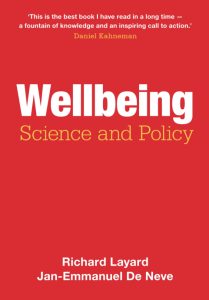In Wellbeing: Science and Policy, Richard Layard and Jan-Emmanuel De Neve present an enquiry into human wellbeing: what factors create it, how can it be effectively measured and how can it be improved? The authors’ rich interdisciplinary examination of how wellbeing can be studied – from sociological research to econometric methods – is a worthwhile read for both experts in the field and newcomers, writes Egor Bronnikov.
Wellbeing: Science and Policy by Richard Layard and Jan-Emmanuel De Neve. Cambridge University Press. 2023.
 Can we obtain a reliable measure of individual wellbeing? Do happier or less happy voters support the incumbent? To what extent is it affected by biological and social factors? Does voter unhappiness lead to populist popularity? A new book – Wellbeing: Science and Policy – by Richard Layard, Co-Director of the Community Wellbeing Programme and Emeritus Professor at the London School of Economics, and Jan-Emmanuel De Neve, Professor of Economics and Behavioural Science at the University of Oxford, demonstrates how contemporary empirical and experimental econometric approaches provide us with answers to these and many other questions.
Can we obtain a reliable measure of individual wellbeing? Do happier or less happy voters support the incumbent? To what extent is it affected by biological and social factors? Does voter unhappiness lead to populist popularity? A new book – Wellbeing: Science and Policy – by Richard Layard, Co-Director of the Community Wellbeing Programme and Emeritus Professor at the London School of Economics, and Jan-Emmanuel De Neve, Professor of Economics and Behavioural Science at the University of Oxford, demonstrates how contemporary empirical and experimental econometric approaches provide us with answers to these and many other questions.
One of the most common types [of qualitative wellbeing assessment] asks individuals to answer the question, “Overall, how satisfied are you with your life nowadays?” by marking their level of satisfaction on a scale from 0 to 10
The book is divided into four parts. The first part – “The Case for Wellbeing” – begins by introducing the concept of wellbeing, which refers to how individuals assess their own feelings. It also discusses typical approaches to its quantitative measurement, which have been documented to be robust (chapter one). One of the most common types (known as an evaluative measure) asks individuals to answer the question, “Overall, how satisfied are you with your life nowadays?” by marking their level of satisfaction on a scale from 0 (“not at all satisfied”) to 10 (“very satisfied”). These measurements are crucial for two primary purposes: first, for understanding the determinants of wellbeing; and, second, for creating improvements in wellbeing which should be – and, in many cases, already are – important for individuals, non-profit organisations, businesses, and governments. In the following chapter, the authors provide a concise history of the philosophical and scientific discourse on wellbeing as the overarching societal goal which is enriched with many examples from famous figures (ranging from Aristotle to Jeremy Bentham and from Francis Hutcheson to John Rawls).
The authors provide a concise history of the philosophical and scientific discourse on wellbeing as the overarching societal goal
The second part – “Human Nature and Wellbeing” – directs the reader’s attention to three key clusters. It begins with a depiction of the contemporary understanding of individual decision-making under the influence of cognitive biases (chapter three), where Layard and De Neve introduce issues that hinder individuals from maximising their wellbeing (such as framing, and lack of self-control). For example, the authors adeptly introduce loss aversion, one of the most crucial concepts in contemporary behavioural economics, by presenting it with simple arithmetic and graphical examples, demystifying the concept. However, this section lacks an exploration of how these human limitations can be leveraged to improve wellbeing (see, for example, a paper by Roland Fryer Jr., Steven Levitt, John List, and Sally Sadoff that demonstrates how loss aversion can be used to enhance the efficacy of teachers’ efforts to increase students’ academic achievements). In the following chapter, the authors rigorously demonstrate how different patterns of thinking interact with human wellbeing. Finally, in chapter five, they delve into neurology and elucidate the interplay between the mind and body, genes and the environment.
The third part of the book – “How Our Experience Affects Our Wellbeing” – constitutes the largest and most elaborate section both in terms of research, the analysis of findings and technical details. It begins with a discussion of overall wellbeing inequality (chapter six). Layard and De Neve – following the style of Mastering Metrics and Mostly Harmless Econometrics – present the empirical strategies employed in their research in a way that will be accessible even to novices (chapter seven).
The authors explore the dynamics of negative and positive experiences over the course of life for males and females, as well as their heterogeneity across countries
Starting from chapter eight, the journey into wellbeing investigation unfolds. The authors explore the dynamics of negative and positive experiences over the course of life for males and females, as well as their heterogeneity across countries (chapter eight). The narrative seamlessly transitions to chapter nine, where research results on the various impacts of schooling, family, and social media are documented. The tenth chapter draws attention to the still relatively under-addressed issue of mental health, providing evidence on how relatively low-cost programs can significantly improve one’s wellbeing.
The psychological impact of losing a job is more severe for wellbeing deterioration than the monetary aspect, and it can have long-lasting effects
The next four chapters, devoted to unemployment, work quality, income and community, respectively can be briefly summarised as follows: (i) the psychological impact of losing a job is more severe for wellbeing deterioration than the monetary aspect, and it can have long-lasting effects even after returning to employment, and (ii) while income level is important, it is not the primary factor affecting job satisfaction. Interpersonal relationships and the degree of job interest for an employee surpass income in their influence. The closing fifteenth chapter introduces the role of climate change, directing the reader’s attention to the looming threat for future generations, the potential free-rider problem among countries, and the importance of international agreements.
Despite the suggestive correlation between happier voters and increased political engagement, research in this field has not yet reached a conclusive relation
The final part – Government and Wellbeing – delves into the matter of wellbeing in terms of its outcome. This section focuses on three domains: government actions toward wellbeing (chapter sixteen), the relationship between voting and wellbeing (chapter seventeen), and the assessment of costs versus gains in public policy choices (chapter eighteen). Chapter Sixteen holds particular significance due to its crucial societal impact and, therefore, deserves more detailed consideration. Despite the suggestive correlation between happier voters and increased political engagement, research in this field has not yet reached a conclusive relation. Results vary significantly depending on the timeline and socio-political context. In contrast, there is well-documented and robust evidence concerning voting with the incumbent’s presence. Happier voters are much more likely to express their preferences for candidates who are already part of the political landscape and empowered. Furthermore, unhappy voters are more inclined to express their preferences for populist candidates and ideologies (for an extensive discussion of definitions of populism, see the paper by Sergei Guriev and Elias Papaioannou published in the Journal of Economic Literature).
Wellbeing […]successfully brings together state-of-the-art empirical and experimental research about the factors affecting human wellbeing
Wellbeing has several advantages. Firstly, it successfully brings together state-of-the-art empirical and experimental research about the factors affecting human wellbeing, which is valuable for both academia and the general public. Secondly, the book encompasses a diverse range of topics, providing overarching discussions on each of them, from the effects of unemployment to the impact of thoughts, and from the role of genes and family to voting behaviour — all in the context of individual wellbeing. Thirdly, Layard and De Neve make extensive use of a significant number of meta-studies (the statistical combination of results from multiple studies) whenever possible, which provides readers with more robust evidence for the authors’ statements.
A […] downside is the absence of explicit articulation of future research avenues.
That said, the book has several minor areas warranting critique. The first is a slightly surprising discrepancy in mathematical usage. For instance, the authors frequently employ regression specifications but avoid using the term “derivative,” opting instead for lengthy explanations that span several lines. A more significant downside is the absence of explicit articulation of future research avenues. While several hints in this regard (indicated only by dotted lines) are present in the final part of the book, a more structured discussion from such well-known researchers would be incredibly beneficial.
Overall, Wellbeing is a great example of a book that appeals to both experts in the field and newcomers. For the former, it broadens researchers’ perspectives while delving into rich technical detail. For the latter, it provides an excellent introduction to the field, accompanied by an explicit and seamless discussion of various econometric techniques.
Note: This review gives the views of the author, and not the position of the LSE Review of Books blog, or of the London School of Economics and Political Science. The LSE RB blog may receive a small commission if you choose to make a purchase through the above Amazon affiliate link. This is entirely independent of the coverage of the book on LSE Review of Books.
Image Credit: Ratana21 on Shutterstock.








Thank you very much for this review – I’ve just bought the book and I look forward to digesting it over the coming weeks!